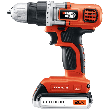Have you ever had a problem with your toilet, called a plumber, only to find out that the problem really wasn't really all that major to begin with. Granted, after finding this out you usually have to pay $100 or more. Diagnosing toilet problems yourself can not only save you some money that you can use in a variety of other ways, by either telling the plumber what the problem is or by being able to fix the problem yourself.
Now that you have a rough idea of where the problem lies, you can begin to either work on the problem or let the plumber know what's going on. With the problem diagnosed, you can easily figure out what you need to do to fix it. Luckily, most of the problems you will be able to fix yourself, or at least you can if you have the right instructions and a bit of self confidence.

MAX Power! A powerful lithium-ion drill/driver that delivers 0-to-650 RPM and 115 inches-per-pound of torque in a lightweight, easy-to-use package. An anti-slip soft grip and LED worklight makes this tool a delight to use. Check out Black & Decker 20-Volt Cordless Drill/Driver today!
Instead of calling plumber save some money by installing your own toilet, it's not as hard as you may think. Here's how.
Discover MoreBefore you can install a toilet, you have to remove your old one. Use this checklist and you are going to be able to do ...
Discover MorePerhaps the single most common plumbing problem in the bathroom is to have a running toilet. Repairing a running toilet ...
Discover More2013-08-02 19:21:03
Norman
I used to use Clorox brand Chlorine discs in the toilet tank only to discover that the chlorine chemically reacted withthe flapper seal and caused the seal to pucker thus leaving no seal and a need to replace the flapper assembly.
Does anyone know of a treatment that won't react with the rubber/plastic material that the flapper assembly is made from?
2013-08-02 14:33:32
Tom
My toilet water in my master bathroom smells horrible. Cleaning the tank and the bowl have no effect on the odor. Three other bathrooms have no problem with the smell--any idea where it is coming from or a solution??
Copyright © 2025 Sharon Parq Associates, Inc.
Comments